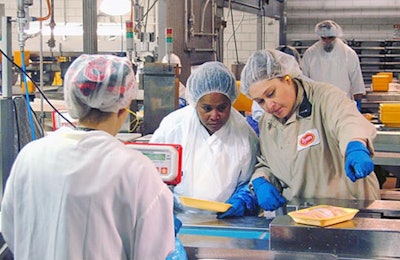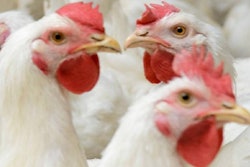
Tyson Foods’ net income for the third quarter of fiscal year 2017 dropped when compared to the same quarter of 2016, but the company remains ahead of pace for net income for the year as a whole.
In releasing its financial results on August 7, Tyson Foods reported a net income of $448 million for the third quarter, down from the $485 million recorded one year ago. For the first nine months of fiscal year 2017, the company reported a net income of $1.383 billion, up slightly from the $1.380 billion for the first nine months of fiscal year 2016.
Third quarter sales for Tyson Foods were at $9.85 billion, up from the $9.4 billion during the third quarter of fiscal year 2016.
“Our team delivered solid results in our third quarter with three of four segments on a GAAP basis and all four segments on an adjusted basis achieving operating margins in or above their normalized ranges. Our total net sales grew 4.8 percent compared to third quarter of 2016, and every segment delivered volume growth behind a strong start to grilling season and new product innovation,” said
Tom Hayes, president and chief executive officer of
AdvancePierre acquisition
Hayes reported that the company completed its acquisition of AdvancePierre Foods in June, and that the integration is well underway.
“The addition of AdvancePierre will further our leadership position in prepared foods as we capitalize on the fast-growing convenience store channel and the fresh retail perimeter across all day parts. Additionally, we’re seeing even greater potential for leveraging our complementary businesses for efficiency.
Hayes added that the company anticipates cumulative net synergies exceeding $200 million within three years.
Tyson Foods segment results
Chicken - Sales volume was up slightly in the nine months of fiscal year 2017, due to better demand for our chicken products, partially offset by operational disruptions from fires at two plants and decreased rendered product sales.
Sales volume was up for the third quarter of fiscal 2017 due to better demand for our chicken products. Average sales price increased for the nine months and third quarter of fiscal 2017 due to sales mix changes. Operating income for the nine months and third quarter of fiscal 2017 was below prior year record results due to higher operating costs which included increased marketing, advertising and promotion spend and compensation and benefit integration expense of $35 million and $5 million for the nine months and third quarter of fiscal 2017, respectively.
Additionally, operating income for the nine months of fiscal 2017 was impacted by $24 million of incremental net costs and lower sales volume attributable to the two plant fires. Feed costs decreased $5 million and $15 million for the nine months and third quarter of fiscal 2017, respectively.
Pork - Sales volume increased for the nine months and third quarter of fiscal 2017 due to strong demand for our pork products and increased exports.
Average sales price increased as demand for Tyson pork products and strong exports outpaced the increase in live hog supplies. Operating income increased as the company maximized its revenues relative to the live hog markets, partially attributable to stronger export markets and operational and mix performance, which were partially offset by higher operating costs.
Prepared Foods - Sales volume increased for the nine months of fiscal 2017 due to improved demand for Tyson retail products and incremental volumes from the AdvancePierre acquisition, partially offset by declines in foodservice. Sales volume increased in the third quarter of fiscal 2017 primarily as the result of incremental volumes from the AdvancePierre acquisition, partially offset by declines in foodservice.
Average sales price was up slightly for the nine months of fiscal 2017 primarily due to better product mix attributable to the AdvancePierre acquisition, partially offset by a decline in input costs of approximately $55 million. Average sales price increased in the third quarter of fiscal 2017 due to better product mix which was positively impacted by the AdvancePierre acquisition and higher input costs of approximately $25 million.
Operating income for the nine months of fiscal 2017 decreased due to an impairment of $52 million related to Tyson’s San Diego operation, in addition to higher operating costs at some company facilities, increased marketing, advertising and promotion spend, $28 million of compensation and benefit integration expense and $21 million related to AdvancePierre purchase accounting and acquisition related costs.
Operating income for the third quarter of fiscal 2017 decreased due to higher operating costs at some facilities and $21 million related to AdvancePierre purchase accounting and acquisition related costs. Additionally, Prepared Foods operating income was positively impacted by $135 million in synergies, of which $19 million was incremental synergies in the third quarter of fiscal 2017. The positive impact of these synergies to operating income was partially offset with investments in innovation, new product launches and supporting the growth of Tyson Foods brands.
Beef - Sales volume increased for the nine months and third quarter of fiscal 2017 due to improved availability of cattle supply, stronger domestic demand for our beef products and increased exports.
Average sales price for the nine months of fiscal 2017 decreased due to increased availability of live cattle supply and lower livestock cost. Average sales price for the third quarter of fiscal 2017 increased as demand for Tyson beef products and strong exports outpaced the increase in live cattle supplies. Operating income increased due to more favorable market conditions as the company maximized its revenues relative to the decline in live fed cattle costs, partially offset by higher operating costs.















